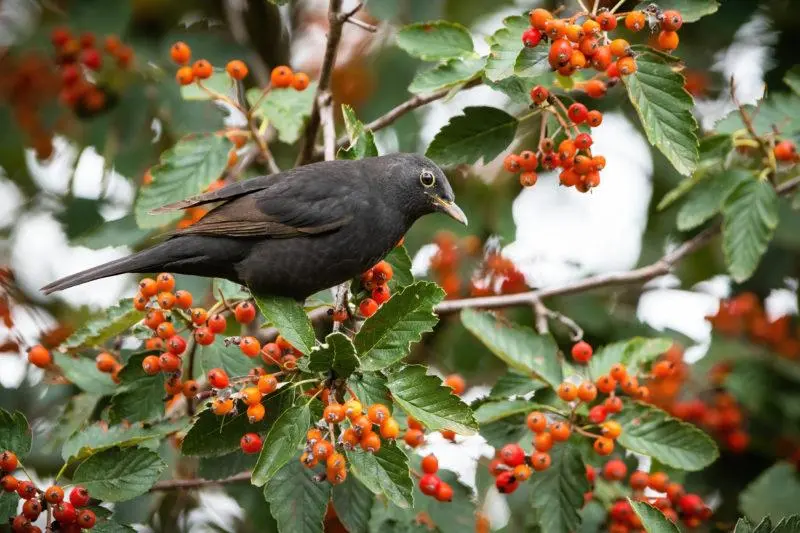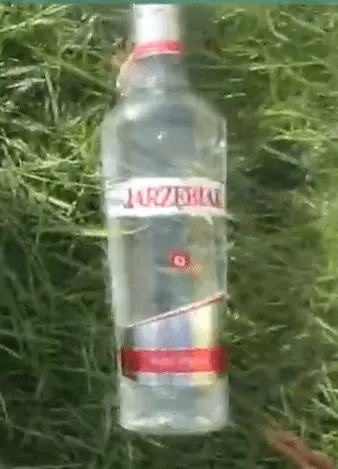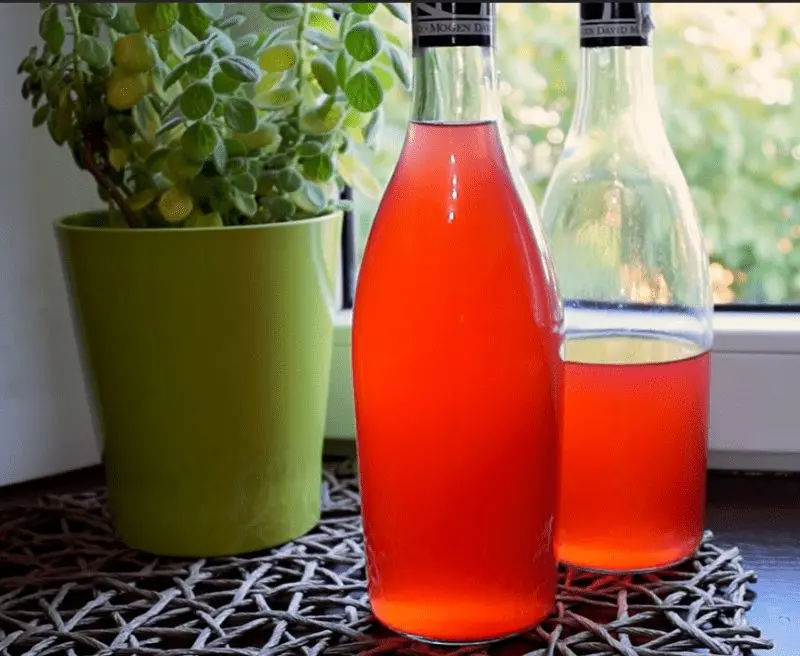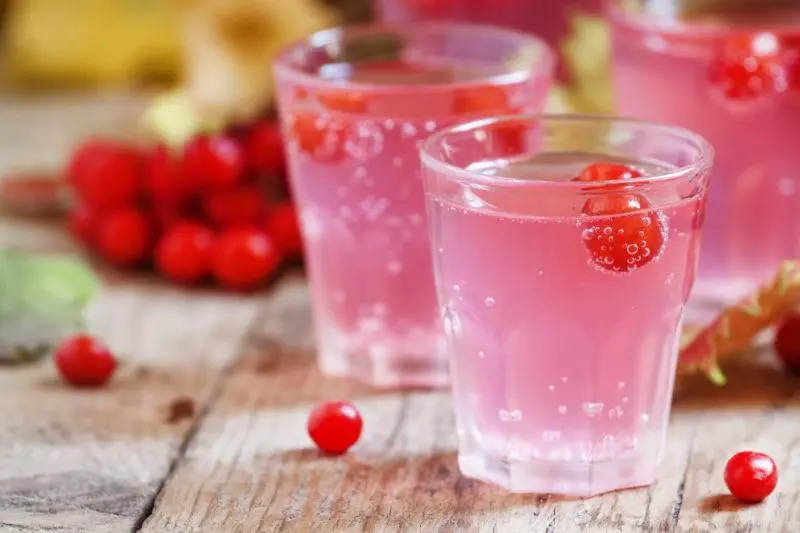Contents
Imagine a rich, berry flavor with the finest sherry and cognac overflows. Represented? Now add to that a complex, layered astringency and a beautiful, often cognac, but predominantly deep ruby color. Added? And now read how to make this unusually easy-to-prepare, but complex-tasting drink from the most accessible raw materials in our latitudes, red rowan tincture.
Yes, it’s really simple and really delicious. The main thing is to collect the right mountain ash and prepare it correctly, the rest will be done by exposure. Basically yours, because rowan tincture gains worthy taste only after 1-2 years of aging. But before that it is important to collect the right mountain ash and properly prepare it!
Red rowan preparation technology
Unripe rowan fruits contain parasorbic acid, which, together with some other substances, gives a bitter taste (and is also toxic, causes vomiting, diarrhea and headache), masking a rather high sugar content (about 8-9%). In the cells of berries there are enzymes that break down bitter parasorbic acid to weakly acidic (and safe) sorbic acid, but they are separated by intracellular membranes. After freezing, the membranes are destroyed, enzymes gain access to acids. That is why rowan should be harvested after the first frost, when it is sweet and almost without bitterness.

But enzymes do not act as fast as we would like. Yes, and it is very difficult to compete with birds for a ripe and sweet berry after frost. Therefore, mountain ash can be harvested in early autumn, and before preparing tinctures and other drinks from it, properly prepare: freeze, dry in the oven and / or blanch. This leads to the final destruction of bitter acid, the fruits become sweeter and safer for health. Toasting in the oven is, in my opinion, the best practice for making delicious rowanberry, but you can try other methods as well.
Schemes for preparing rowan fruits for infusion:
- Rowan collected after frost (November-December).
- Carefully sort out the rowan from twigs and spoiled berries, rinse under running water and dry in a heated to 75-80 оFrom the oven (you can leave the door open to let the moisture out) until it gives juice and wrinkles a little. You can experiment with caramelizing juices at higher temperatures (up to 180 оC for 15-20+ minutes) – will add color and complexity.
- If the berry is still bitter, then before preparing the tincture, it can be doused several times with boiling water, placed in a sieve or colander.
- Rowan harvested before frost (September-October).
- Sort, rinse, dry on a towel and freeze for 1,5-7 days. Allow to thaw and drain, and then into the oven according to the old scheme. Additionally, you can pour boiling water over several times, dry and can be used.
The procedures for baking and washing with boiling water can be interchanged. You can get by with just drying or just blanching. It all depends on the quality of the mountain ash, but I am for the oven – the taste is more interesting, the color is richer, and boiling water does not wash out the flavors in the skin. Even if the bitterness does not go away completely, after a year of aging it will transform into noble astringency, sherry and cognac notes will appear in the drink. Checked multiple times!
And a few words about the quality of the mountain ash itself. Of course, berries should be picked away from the roads, ideally outside the city. There are cultivated varieties, not bitter, juicy and very sweet. So for tincture it is better to take smaller berries, albeit bitter ones – they will give much more taste and aroma. It is better to make worthy wines or liqueurs from sweet rowan, reducing the amount of additional sugars. Don Pomazan, my colleague and good friend, offers waste-free schemes for processing rowan berries according to the “wine – tincture – liquor” scheme. I recommend to read and implement!
Recipe “Nezhinsky mountain ash” – old
As the beautiful story says, the most delicious and not bitter mountain ash grows near the village of Nevezhina, Vladimir province, near Suzdal. It was from it, and not from the mountain ash around Nizhyn, Chernihiv region, that the first tincture from red mountain ash was prepared by Arseniy Smirnov. In 1889, the drink received the Big Gold Medal at the World Exhibition in Paris (a very prestigious award in those years) and became a real sensation for European drinkers. I hope that the prize “Nezhinskaya Rowan” will be a sensation for you too.

- prepared red rowan fruits
- vodka / alcohol / moonshine 45-50% – as needed
How to cook:
- Prepare the berries according to the instructions above and transfer to a container. You can use glass jars of any size or even take an oak barrel that has worked well with other drinks for this (the drink will only benefit from this).
- Pour vodka, fruit / grain distillate or alcohol diluted to 45-50% over rowan. Berries must be completely immersed in alcohol. Close the container tightly and leave in a dark, cool place.
- After a day, check the container and add more vodka so that it covers the berries again (the mountain ash should swell and absorb a certain amount of vodka in the first 24 hours). The procedure should be repeated for the first 3-4 days.
- After 12-14 days, the rowan tincture should be gently mixed: if a barrel was used as a container, drain the infusion through a screwed-in tap and then return it back; It is enough to turn the glass container upside down. You can’t shake it, because the berry can crack – the alcohol should gradually extract the flavor components, this is the secret of the softness and taste balance acquired by the drink.
- The mixing procedure should be repeated every 12-14 days. Nezhinskaya rowan vodka can be drained after 6-8 weeks of infusion, but it is better to do the following:
- After 3-4 weeks, drain 1-2 bottles (depending on the amount) of infusion and top up with fresh vodka / alcohol / moonshine.
- After 2-4 weeks, repeat the procedure and do so until the ash is felt in the infusion.
- When the taste is gone, the infusion should be left for a year, after which it should be drained and used as directed.
- Previously merged parties also need to withstand at least 6 months, and preferably a year or two – the longer the better. The first two plums give an incredibly tasty drink, which, after a year of aging, surpasses many elite drinks in taste.
- Before bottling rowan vodka, it is advisable to filter it through a cotton or coffee filter. To soften, you can add a little sugar, literally 1-1,5 tbsp. l. per liter (dextrose or fructose is better, and caramel can also be sweetened for color). Store in a cool dark place. Shelf-life Unlimited.
Recipes for Polish tincture of red rowan “Jarzębiak”
Jarzębiak is a famous Polish fruit vodka made from rowanberry tincture with fruit distillates, grape brandy and caramel. A well-known Polish publicist, Jan Cieślak, defines a slightly different drink with this name: an alcoholic tincture of bitter rowan fruits (lightly frozen), supplemented with prunes, raisins, figs and grape brandy.
 In the 1960s and 1970s, “jarzębiak”, which was produced in the small town of Zielona Góra, was one of the most popular fruit vodkas in the country. He received the quality mark “Q” and a gold medal at the international competition of the Belgian quality institute Monde Selection in Athens (1988). Later, the drink was repeatedly awarded medals at prestigious exhibitions and fairs. A serious production line was set up, which in the best years produced up to half a million liters per year. Polish rowan vodka was then exported not only to European countries, but also to other continents, for example, to Brazil, Japan and Australia.
In the 1960s and 1970s, “jarzębiak”, which was produced in the small town of Zielona Góra, was one of the most popular fruit vodkas in the country. He received the quality mark “Q” and a gold medal at the international competition of the Belgian quality institute Monde Selection in Athens (1988). Later, the drink was repeatedly awarded medals at prestigious exhibitions and fairs. A serious production line was set up, which in the best years produced up to half a million liters per year. Polish rowan vodka was then exported not only to European countries, but also to other continents, for example, to Brazil, Japan and Australia.
Ryabinka from the village of Izdebnik (Lesser Poland Voivodeship), “jarzębiak izdebnicki”, the tradition of making which dates back to the 16th century, was in particular demand. This is dry vodka with the addition of mountain ash, herbs and young shoots of pine. In the 19th century, it was mass-produced at the Izdebnik distillery, at the court of Archduke Rainer Ferdinand of Austria from the Hubsburgs. Unfortunately, her recipe has either been lost or is under seven seals, just like the original recipe for jarzębiak from Zielona Góra.
But, thanks to literary sources and the enthusiasm of Polish moonshiners, some successful recipes have come down to us. The first of them is based on the preparation of an aromatic concentrate with its subsequent mixing into a moderately dry, fine, noble vodka or cognac tincture.

Concentrate for Polish ryabinka “Jarzębiak”
- 150 g rowan fruits
- 30-40 g pitted prunes
- 40-50 g dark raisins
- 15 g dried hawthorn or pitted blackthorn*
- 1 liter alcohol or grain/fruit moonshine 50%
*- hawthorn or blackthorn fruits are not necessary, but desirable, since they significantly improve the taste of vodka, add complexity and depth to the drink. Good results are obtained by adding a few dates and dried figs to the concentrate.
Prepare the rowan as described above. Rinse prunes, hawthorn or blackthorn, dry and chop coarsely. Pour all the ingredients into a jar of a suitable volume and pour diluted alcohol. Insist in a dark, cool place for at least 30 days, then strain the infusion and seal tightly. To draw out the aromatic alcohol remaining in the fruits, pour 100-150 ml of clean water into the solid residue in the jar, let stand for 24 hours and strain into the previously drained infusion.
Now you can make two amazing drinks from the concentrate…

Rowan vodka “Jarzębiak” (strength ~40%)
- 1 l concentrate for “Jarzębiak”
- 8,75 liters of quality vodka or moonshine 40%
- syrup from 0,25 kg of sugar and 0,25 l of water
Mix all ingredients and keep for 3-6 months.


Rowan on cognac from concentrate (strength ~ 43%)
- 1 l concentrate for “Jarzębiak”
- 9,5 liters of alcohol or moonshine 45%
- 0,5 liters of grape brandy
- syrup from 0,2 kg of sugar and 0,2 l of water
Mix all ingredients and keep for 3-6 months. The amount of cognac can be increased to 0,75 or 1 liter or more, which will only benefit the drink.
The Poles also have less delicate jarzębiak recipes. For example: put 150 g of oven-dried mountain ash, 10 pieces of pitted prunes and a handful of raisins into a jar, and then pour everything with a liter of vodka. The jar will need to be tightly closed and left for 3 weeks in a dark, cool place. The tincture must be shaken at least once every few days. Then strain, filter and bottle. The remaining berries can be poured with vodka again and after 24 hours, drain the second infusion to the first. Exposure is, of course, welcome.
Ryabinovka with cognac “Prigranichnaya”/”Jarzębiak Kresowy”
This is a more elegant version, well-designed, albeit without proper accuracy. However, without creativity in our business you will not go far. It was taken (and repeatedly tested) from the book “Księga smaków Lubelszczyzny”, written by a well-known Lublin journalist named Waldemar Sulisz (I was afraid to take on transcription). He loves to write about food and, in particular, about forgotten Polish spirits. Everything is balanced in this tincture, because the Poles have more than 400 years of experience in making Jarzębiak!

- a handful of red rowan fruits
- 6 pcs. pitted prunes
- 3 dried figs
- 1 st. l. chopped dried thorn
- 1 st. l. dark raisins
- 2-3 Carnation Bud
- piece of ginger root 2-2,5 cm
- 500 ml food grade alcohol 95,6%
- 200 ml rye vodka/distillate
- 100 ml cognac / fruit moonshine
- 400 ml boiled water
Dry the rowan in the oven, and then pour boiling water over several times. Put the fruits in a jar, add chopped dried fruits, cloves, peeled and finely chopped ginger root, alcohol, vodka and cognac. Close the jar tightly and leave in a dark, cool place for 3-4 weeks. Shake the contents of the jar every few days. Then strain the infusion, filter through a cotton or coffee filter, and pour the dry residue with boiled water and let it brew for 24 hours. Strain, add water to the tincture, which can be immediately poured into clean bottles. After six months, you can try.
Similar bookmarks of mountain ash and dried fruits can be poured up to three times: the first time with alcohol 60-70 degrees for 4-6 weeks, then with alcohol 50% for another 2-4 weeks, and then with water in volume, so that when mixing infusions, a strength of 38-45 is obtained %. The main thing is that during the infusion all the berries are immersed in alcohol.
Simple rowan tincture on vodka
And now let’s just dream up, armed with many years of experience in making homemade drinks and a reliable, simple as 2×2 recipe for rowanberry on vodka. Let’s take the base first:

- 2 kg of rowan fruits
- up to 100 g of sugar
- 2,5 liters of vodka
How to do it:
Prepare the mountain ash according to the instructions above, place in a jar of a suitable volume, sprinkle with sugar and pour vodka or, in order not to lose the degree, alcohol / moonshine with a strength of 50%. Close the jar tightly and leave in a dark, cool place for 4-6 weeks. Then strain, filter and pour into bottles. A year or two of exposure is welcome, the shelf life is not limited.
So what can we do with this splendor? For starters, you can replace half of the vodka with high-quality grape brandy – you get a classic, mountain ash on cognac. Not bad. Little oak? A trifling matter – add well-done oak chips, about 4 g / l and for 2-3 months. You can also take oak bars, a format that is more understandable to our moonshiner. Instructions for their manufacture, preparation and dosage are attached. Here, now it’s better, straight cognac XO.

Not enough freshness? The zest of one lemon will add it. The main thing is to remove the zest without white albedo, we will have enough bitterness without it. Don’t understand what it’s about? Read about lemon vodka, but it’s better to read about the flawless Limoncello from Sorrento right away. The juice of two lemons, thanks to active acids, will accelerate the maturation of the drink and in just six months you can enjoy a delicate balance of berry astringency and citrus sourness. But oxidative processes cannot be stopped, so this rowanberry will rapidly degrade in taste and it is better to use it quickly, within 1 year after bottling (I think you can manage it in six months).
Finally, following Polish ideas about this drink, you can add dried fruits. Prunes work flawlessly, 100 g per 2,5 liters of alcohol is enough in full. A little smoked good scotch won’t hurt. By the way, it is reasonable to replace sugar with honey. But that’s up to you to imagine.
Fantasize and feel free to share your discoveries! We are sharing…









